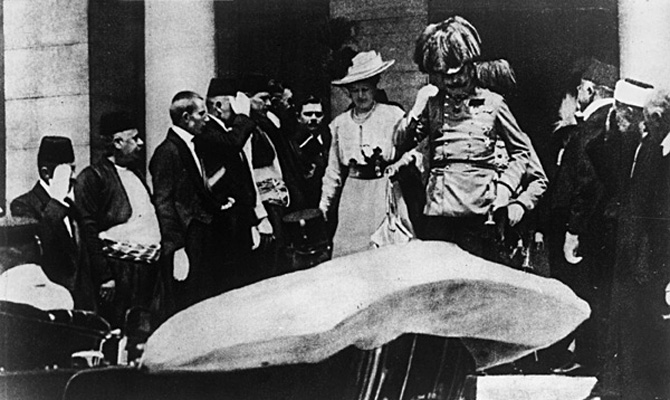|
 The assassination of Archduke Ferdinand
The assassination of Archduke Ferdinand
|
|
"On 28 June 1914 Archduke Franz Ferdinand of Austria, heir apparent to the Austro-Hungarian throne, and his wife, Sophie, Duchess of Hohenberg were shot dead in Sarajevo, by Gavrilo Princip, one of a group of six Bosnian Serb assassins coordinated by Danilo Ilic. The political objective of the assassination was to break off Austria-Hungary's south-Slav provinces so they could be combined into a Greater Serbia or a Yugoslavia. The assassins' motives were consistent with the movement that later became known as Young Bosnia. Serbian military officers stood behind the attack."1
| |
|
It was in the pages of the Revue internationale des Sociétés Sècretes, founded in 1912 in Paris, that editer L'abbé Ernest Jouin (1844-1932), first claimed that the murder of the Austrian Archduke Franz Ferdinand and his wife, Sophie, at Sarajevo in 1914 was an anti-catholic, anti-papal plot.2
The assassination was soon blamed on the freemasons by Miss. Elizabeth Durham in The Sarajavo Crime:
"During the trial of Archduke Ferdinand’s killer, Gavrillo Princep testified that his colleague, Ciganovich, "told me he was a Freemason" and "on another occasion told me that the Heir Apparent had been condemned to death by a Freemason’s lodge." Moreover, another of the accused assassins, Chabrinovitch, testified that Major Tankositch, one of the plotters, was a Freemason."3
She offered a document of the minutes of the trial of the murderers as evidence. This was proved to be a forgery of Father [Anton] Puntigam (d. 1926), a Jesuit of Sarajevo. "Substantial evidence pointed to the fact that the author had been the dupe of one named H. C. Norman, an anti-Mason, and one Horatio Bottomley (1860/03/23-1933/05/26), later proved to be a swindler."4
"Her document purported to have been written by 'Professor Pharos'; it was discovered that "Professor Pharos" was Father Puntigam, leader of the Jesuits in Sarajevo. Even the Rev. Father Hermann Gruber, S. J., who was an Anti-Mason by profession, protested against this dreadful hoax; he pointed out among other things that whereas the assassins were under twenty years of age, it was the common rule in Danubian Masonry to accept no candidate under twenty-five."5
|
|
1. Wikipedia, accessed 2010/10/09.
2. Wikipedia, accessed 2010/10/09.
2. Revue internationale des Sociétés Sècretes, July 1914 (issue viii), p. 12.
3. Revue internationale des Sociétés Sècretes, July 1914 (issue viii), p. 12.
3. The Sarajevo Crime, Mary Edith Durham. London : George Allyn and Unwinn, Ltd., 1925, pp. 85-86.
4. The Sarajevo Crime, Mary Edith Durham. London : George Allyn and Unwinn, Ltd., 1925, pp. 85-86.
4. Ars Quator Coronatorum vol LCCC (1968) p. 251.
5. Ars Quator Coronatorum vol LCCC (1968) p. 251.
5. Supplement to Mackey’s Encyclopedia of Freemasonry, H. L. Haywood. Richmond, Virginia : Macoy Publishing, 1966. p. 1361. Supplement to Mackey’s Encyclopedia of Freemasonry, H. L. Haywood. Richmond, Virginia : Macoy Publishing, 1966. p. 1361.
|
|

![[Grand Lodge]](../images/hedn.jpg)